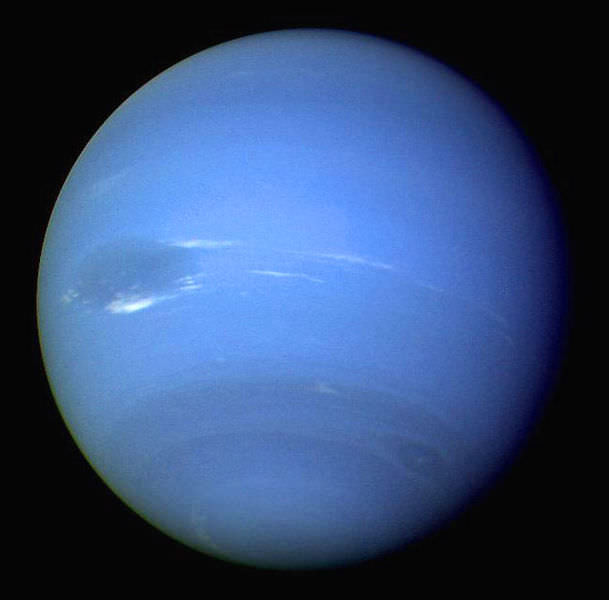So, you think you know Galileo? A new book out from Simon and Schuster publishing looks at the exploits of one of the most famous astronomers there ever was: Galileo Galilei. Galileo and the Science Deniers by Dr. Mario Livio not only looks at the life and times of the famous astronomer, but busts some of the most famous myths surrounding Galileo, and looks at his greatest discoveries and tempestuous clash with the Roman Catholic Church and its aftermath. Livio also connects the science denialism of the day with comparisons to modern clashes between politics and science.
Continue reading “Review: Galileo and the Science Deniers by Mario Livio”What is Galileo’s Telescope?
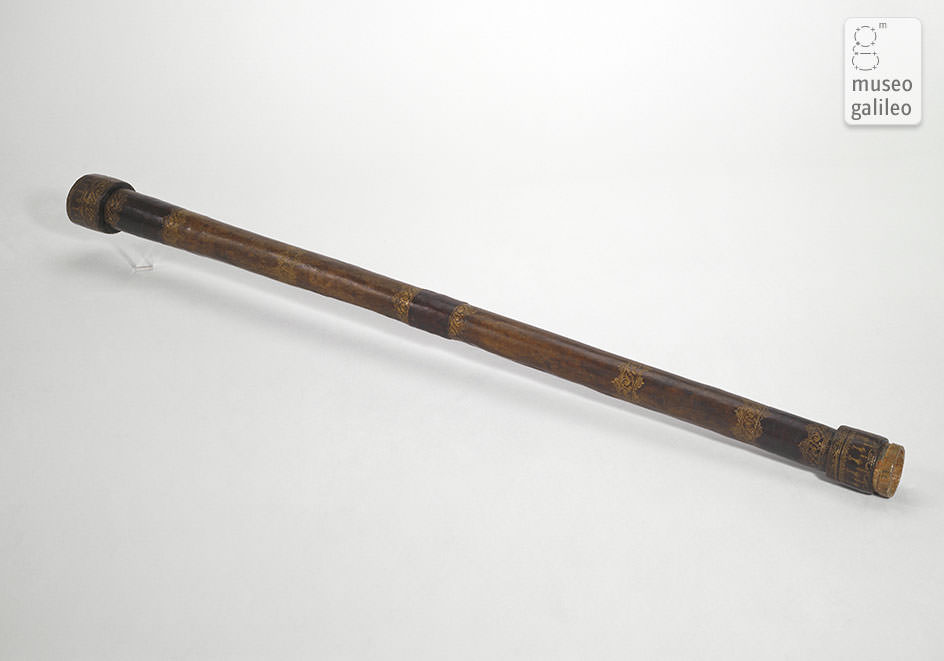
In 1610, Italian astronomer Galileo Galilei looked up at the heavens using a telescope of his making. And what he saw would forever revolutionize the field of astronomy, our understanding of the Universe, and our place in it. Centuries later, Galileo’s is still held in such high esteem; not only for the groundbreaking research he conducted, but because of his immense ingenuity in developing his own research tools.
And at the center of it all is Galileo’s famous telescope, which still inspires curiosity centuries later. How exactly did he invent it. How exactly was it an improvement on then-current designs? What exactly did he see with it when he looked up at the night sky? And what has become of it today? Luckily, all of these are questions we are able to answer.
Description:
Galileo’s telescope was the prototype of the modern day refractor telescope. As you can see from this diagram below, which is taken from Galileo’s own work – Sidereus Nuncius (“The Starry Messenger”) – it was a simple arrangement of lenses that first began with optician’s glass fixed to either end of a hollow cylinder.

Galileo had no diagrams to work from, and instead relied on his own system of trial and error to achieve the proper placement of the lenses. In Galileo’s telescope the objective lens was convex and the eye lens was concave (today’s telescopes make use of two convex lenses). Galileo knew that light from an object placed at a distance from a convex lens created an identical image on the opposite side of the lens.
He also knew that if he used a concave lens, the object would appear on the same side of the lens where the object was located. If moved at a distance, it appeared larger than the object. It took a lot of work and different arrangements to get the lens the proper sizes and distances apart, but Galileo’s telescope remained the most powerful and accurately built for a great many years.
History of Galileo’s Telescope:
Naturally, Galileo’s telescope had some historical antecedents. In the late summer of 1608, a new invention was all the rage in Europe – the spyglass. These low power telescopes were likely made by almost all advanced opticians, but the very first was credited to Hans Lippershey of Holland. These primitive telescopes only magnified the view a few times over.
Much like our modern times, the manufacturers were quickly trying to corner the market with their invention. But Galileo Galilei’s friends convinced his own government to wait – sure that he could improve the design. When Galileo heard of this new optical instrument he set about engineering and making improved versions, with higher magnification.
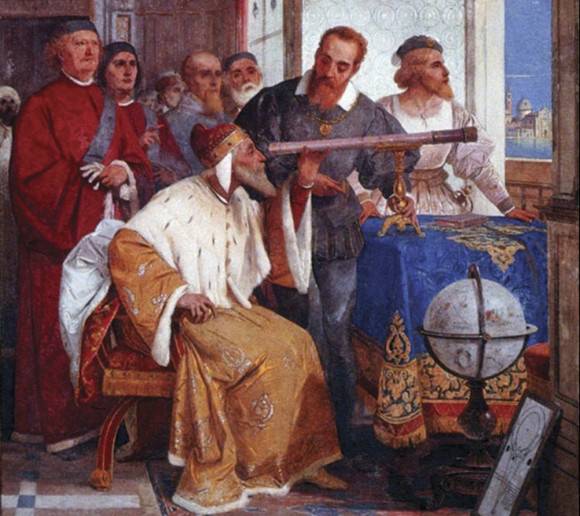
Galileo’s telescope was similar to how a pair of opera glasses work – a simple arrangement of glass lenses to magnify objects. His first versions only improved the view to the eighth power, but Galileo’s telescope steadily improved. Within a few years, he began grinding his own lenses and changing his arrays. Galileo’s telescope was now capable of magnifying normal vision by a factor of 10, but it had a very narrow field of view.
However, this limited ability didn’t stop Galileo from using his telescope to make some amazing observations of the heavens. And what he saw, and recorded for posterity, was nothing short of game-changing.
What Galileo Observed:
One fine Fall evening, Galileo pointed his telescope towards the one thing that people thought was perfectly smooth and as polished as a gemstone – the Moon. Imagine his surprise when found that it, in his own words, was “uneven, rough, full of cavities and prominences.” Galileo’s telescope had its flaws, such as a narrow field of view that could only show about one quarter of the lunar disk without repositioning.
Nevertheless, a revolution in astronomy had begun! Months passed, and Galileo’s telescope improved. On January 7th, 1610, he turned his new 30 power telescope towards Jupiter, and found three small, bright “stars” near the planet. One was off to the west, the other two were to the east, and all three were in a straight line. The following evening, Galileo once again took a look at Jupiter, and found that all three of the “stars” were now west of the planet – still in a straight line!
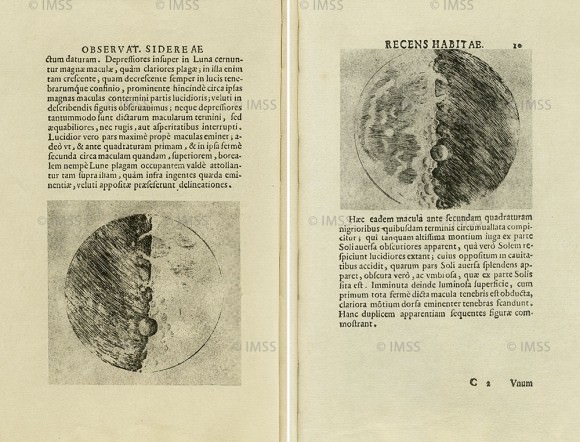
And there were more discoveries awaiting Galileo’s telescope: the appearance of bumps next to the planet Saturn (the edges of Saturn’s rings), spots on the Sun’s surface (aka. Sunspots), and seeing Venus change from a full disk to a slender crescent. Galileo Galilei published all of these findings in a small book titled Sidereus Nuncius (“The Starry Messenger”) in 1610.
While Galileo was not the first astronomer to point a telescope towards the heavens, he was the first to do so scientifically and methodically. Not only that, but the comprehensive notes he took on his observations, and the publication of his discoveries, would have a revolutionary impact on astronomy and many other fields of science.
Galileo’s Telescope Today:
Today, over 400 years later, Galileo’s Telescope still survives under the constant care of the Istituto e Museo di Storia della Scienza (renamed the Museo Galileo in 2010) in Italy. The Museum holds exhibitions on Galileo’s telescope and the observations he made with it. The displays consist of these rare and precious instruments – including the objective lens created by the master and the only two existing telescopes built by Galileo himself.
Thanks to Galileo’s careful record keeping, craftsmen around the world have recreated Galileo’s telescope for museums and replicas are now sold for amateurs and collectors as well. Despite the fact that astronomers now have telescopes of immense power at their disposal, many still prefer to go the DIY route, just like Galileo!
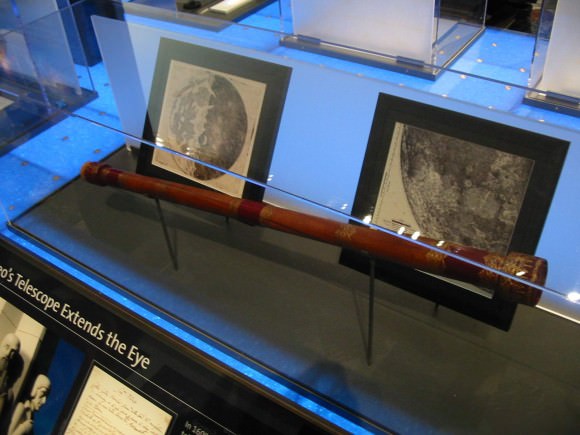
Few scientists and astronomers have had the same impact Galileo had. Even fewer are regarded as pioneers in the sciences, or revolutionary thinkers who forever changed humanity’s perception of the heavens and their place within it. Little wonder then why his most prized instrument is kept so well preserved, and is still the subject of study over four centuries later.
We have written many interesting articles on Galileo here at Universe Today. Here’s
Astronomy Cast also has an interesting episode on telescope making – Episode 327: Telescope Making, Part I
For more information, be sure to check out the Museo Galileo‘s website.
The Juno Mission
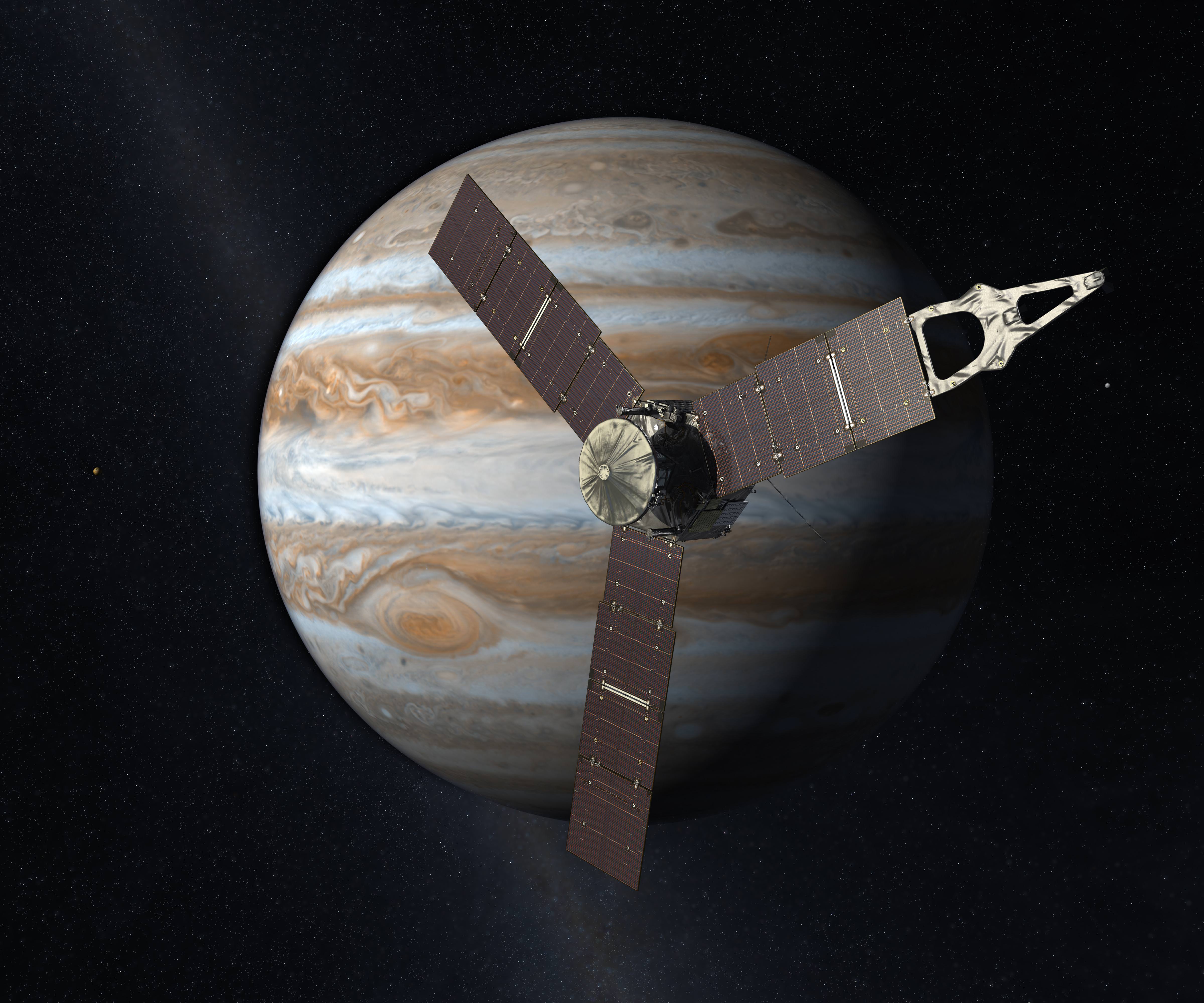
Ever since Galileo first observed it through a telescope in 1610, Jupiter and its system of moons have fascinated humanity. And while many spacecraft have visited the system in the past forty years, the majority of these missions were flybys. With the exception of the Galileo space probe, the visits of these spacecraft to the Jupiter system were one of several intended objectives, taking place before they made their way deeper into the Solar System.
Having launched on August 5th, 2011, NASA’s Juno spacecraft has a different purpose in mind. Using a suite of scientific instruments, Juno will study Jupiter’s atmosphere, magnetic environment, weather patterns, and shed light on the history of its formation. In essence, it will be the first probe since the Galileo mission to orbit Jupiter, where it will spend the next two years sending information about the gas giant back to Earth.
If successful, Juno will prove to be the only other long-term mission to Jupiter. However, compared to Galileo – which spent seven years in orbit around the gas giant – Juno’s mission is planned to last for just two years. However, its improved suite of instruments are expected to provide a wealth of information in that time. And barring any mission extensions, its targeted impact on the surface of Jupiter will take place in February of 2018.
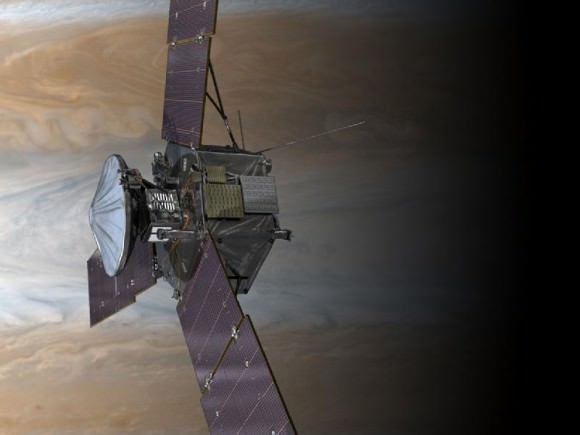
Background:
As part of the NASA’s New Frontiers program, the Juno mission is one of several medium-sized missions intended to explore the various bodies of the Solar System. It is currently one of three probes that NASA is operating, or in the process of building. The other two are the New Horizons probe (which flew by Pluto in 2015) and OSIRIS-REx, which is expected to fly to asteroid 101955 Bennu in 2020 and bring samples back to Earth.
During a 2003 decadal survey – titled “New Frontiers in the Solar System: An Integrated Exploration Strategy” – The National Research Council discussed destinations that would serve as the source for the first competition for the New Frontiers program. A Jupiter orbiter was identified as a scientific priority, which it was hoped would address several unanswered questions pertaining to the gas giant.
These included whether or not Jupiter had a central core (the research of which would help establish how the planet was formed), the water content of Jupiter’s atmosphere, how its weather systems can remain stable, and what the nature of the magnetic field and plasma surrounding Jupiter are. In 2005, Juno was selected for the New Frontiers program alongside New Horizons and OSIRIS-REx.
Though it was originally intended to launch in 2009, NASA budget restrictions forced a delay until August of 2011. The probe was named in honor of the Roman goddess Juno, the wife of Jupiter (the Roman equivalent of Zeus) who was able to peer through a veil of clouds that Jupiter drew around himself. The name was previously a backronym which stood for JUpiter Near-polar Orbiter as well.
Mission Profile:
The Juno mission was created for the specific purpose of studying Jupiter for the sake of learning more about the formation of the Solar System. For some time, astronomers have understood that Jupiter played an important role in the development Solar System. Like the other gas giants, it was assembled during the early stages, before our Sun had the chance to absorb or blow away the light gases in the huge cloud from which they were born.
As such, Jupiter’s composition could tell us much about the early Solar System. Similarly, the gas giants are believed to have played a major role in the process of planet formation because their huge masses allowed them to shape the orbits of other objects – planets, asteroids and comets – in their planetary systems.
However, for astronomers and planetary scientists, much still remains unknown about this massive gas giant. For instance, Jupiter’s interior structure and composition, as well as what drives its magnetic field, are still the subject of theory. Because Jupiter formed at the same time as the Sun, their chemical compositions should be similar, but research has shown that Jupiter has more heavy elements than our Sun (such as carbon and nitrogen).
In addition, there are some unanswered questions about when and where the planet formed. While it may have formed in its current orbit, some evidence suggests that it could have formed farther from the sun before migrating inward. All of these questions, it is hoped, are things the Juno mission will answer.
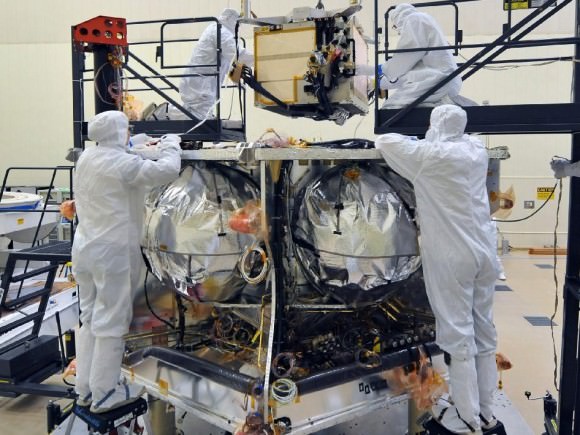
Having launched on August 5th, 2011, the Juno spacecraft spent the next five years in space, and will reach Jupiter on July 4th, 2018. Once in orbit, it will spend the next two years orbiting the planet a total of 37 times from pole to pole, using its scientific instruments to probe beneath the gas giant’s obscuring cloud cover.
Instrumentation:
The Juno spacecraft comes equipped with a scientific suite of 8 instruments that will allow it to study Jupiter’s atmosphere, magnetic and gravitational field, weather patterns, its internal structure, and its formational history. They include:
- Gravity Science: Using radio waves and measuring them for Doppler effect, this instrument will measure the distribution of mass inside Jupiter to create a gravity map. Small variations in gravity along the orbital path of the probe will induce small changes in velocity. The principle investigators of this instrument are John Anderson of NASA’s Jet Propulsion Laboratory and Luciano Iess of the Sapienza University of Rome.
- JunoCam: This visible light/telescope is the spacecraft’s only imaging device. Intended for public outreach and education, it will provide breathtaking pictures of Jupiter and the Solar System, but will operate for only seven orbits around Jupiter (due to the effect Jupiter’s radiation and magnetic field have on instruments). The PI for this instrument is Michael C. Malin, of Malin Space Science Systems
- Jovian Auroral Distribution Experiment (JADE): Using three energetic particle detectors, the JADE instrument will measure the angular distribution, energy, and velocity vector of low energy ions and electrons in the auroras of Jupiter. The PI is David McComas of the Southwest Research Institute (SwRI).
- Jovian Energetic Particle Detector Instrument (JEDI): Like JADE, JEDI will measure the angular distribution and the velocity vector of ions and electrons, but at high-energy and in the magnetosphere of Jupiter. The PI is Barry Mauk of NASA’s Applied Physics Laboratory.
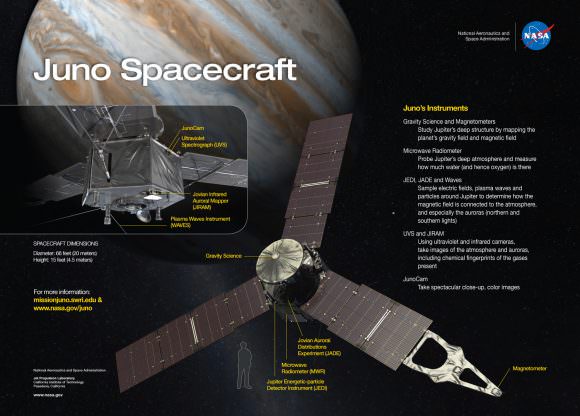
- Jovian Infrared Aural Mapper (JIRAM): Operating in the near-infrared, this spectrometer will be responsible for mapping the upper layers of Jupiter’s atmosphere. By measuring the heat that is radiated outward, it will determine how water-rich clouds can float beneath the surface. It will also be able to assess the distribution of methane, water vapor, ammonia and phosphine in Jupiter’s atmosphere. Angioletta Coradini of the Italian National Institute for Astrophysics is the PI on this instrument.
- Magnetometer: This instrument will be used to map Jupiter’s magnetic field, determine the dynamics of the planet’s interior and determine the three-dimensional structure of the polar magnetosphere. Jack Connemey of NASA’s Goddard Space Flight Center is the instrument’s PI.
- Microwave Radiometer: The MR instrument will perform measurements of the electromagnetic waves that pass through the Jovian atmosphere, measuring the abundance of water and ammonia in its deep layers. In so doing, it will obtain a temperature profile at various levels and determine how deep the atmospheric circulation of Jupiter is. The PI for this instrument is Mike Janssen of the JPL.
- Radio and Plasma Wave Sensor (RPWS): This RPWS will measure the radio and plasma spectra in Jupiter’s auroral region. In the process, it will identify the regions of auroral currents that define the planet’s radio emissions and accelerate its auroral particles. William Kurth of the University of Iowa is the PI.
- Ultraviolet Imaging Spectrograph (UVS): The UVS will record the wavelength, position and arrival time of detected ultraviolet photons, providing spectral images of the UV auroral emissions in the polar magnetosphere. G. Randall Gladstone of the SwRI is the PI.
In addition to its scientific suite, the Juno spacecraft also carries a commemorative plaque dedicated to Galileo Galilei. The plaque was provided by the Italian Space Agency and depicts a portrait of Galileo, as well as script that had been composed by Galileo himself on the occasion that he observed Jupiter’s four largest moons (known today as the Galilean Moons).
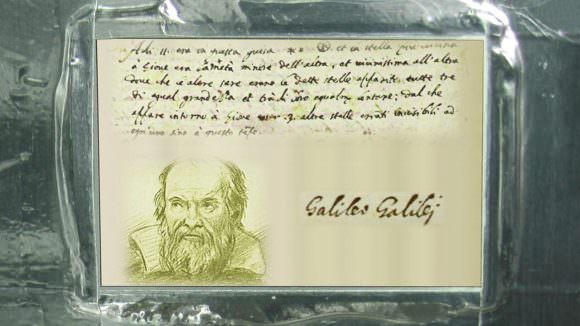
The text, written in Italian and transcribed from Galileo’s own handwriting, translates as:
“On the 11th it was in this formation, and the star closest to Jupiter was half the size than the other and very close to the other so that during the previous nights all of the three observed stars looked of the same dimension and among them equally afar; so that it is evident that around Jupiter there are three moving stars invisible till this time to everyone.”
The spacecraft also carries three Lego figurines representing Galileo, the Roman god Jupiter and his wife Juno. The figure of Juno holds a magnifying glass as a sign of her searching for the truth, Jupiter holds a lightning bolt, and the figure of Galileo Galilei holds his famous telescope. Lego made these figurines out of aluminum (instead of the usual plastic) to ensure they would survive the extreme conditions of space flight.
Launch:
The Juno mission launched from Cape Canaveral Air Force Station on August 5th, 2011, atop an Atlas V rocket. After approximately 1 minute and 33 seconds, the five Solid Rocket Boosters (SRBs) reached burnout and then fell away. After 4 minutes and 26 seconds after liftoff, the Atlas V main engine cut off, followed 16 seconds later by the separation of the Centaur upper stage rocket.
After a burn that lasted for 6 minutes, the Centaur was put into its initial parking orbit. It coasted for approximately 30 minutes before its engine conducted a second firing which lasted for 9 minutes, putting the spacecraft on an Earth escape trajectory. About 54 minutes after launch, the spacecraft separated from the Centaur and began to extend its solar panels.
A year after launch, between August and September 2012, the Juno spacecraft successfully conducted two Deep Space Maneuvers designed to correct its trajectory. The first maneuver (DSM-1) occurred on August 30th, 2012, with the main engine firing for approximately 30 minutes and altering its velocity by about 388 m/s (1396.8 km/h; 867 mph).
The second maneuver (DSM-2), which had a similar duration and resulted in a similar velocity change, took place on September 14th. The two firings occurred when the probe was about 480 million km (298 million miles) from Earth, and altered the spacecraft’s speed and its Jupiter-bound trajectory, setting the stage for a gravity assist from its flyby of Earth.
Earth Flyby:
Juno’s Earth flyby took place on October 9th, 2013, after the spacecraft completed one elliptical orbit around the Sun. During its closest approach, the probe was at an altitude of about 560 kilometers (348 miles). The Earth flyby boosted Juno’s velocity by 3,900 m/s (14162 km/h; 8,800 mph) and placed the spacecraft on its final flight path for Jupiter.
During the flyby, Juno’s Magnetic Field Investigation (MAG) instrument managed to capture some low-resolution images of the Earth and Moon. These images were taken while the Juno probe was about 966,000 km (600,000 mi) away from Earth – about three times the Earth-moon separation. They were later combined by technicians at NASA’s JPL to create the video shown above.
The Earth flyby was also used as a rehearsal by the Juno science team to test some of the spacecraft’s instruments and to practice certain procedures that will be used once the probe arrives at Jupiter.
Rendezvous With Jupiter:
The Juno spacecraft reached the Jupiter system and established polar orbit around the gas giant on July 4th, 2016. It’s orbit will be highly elliptical and will take it close to the poles – within 4,300 km (2,672 mi) – before reaching beyond the orbit of Callisto, the most distant of Jupiter’s large moons (at an average distance of 1,882,700 km or 1,169,855.5 mi).
This orbit will allow the spacecraft to avoid long-term contact with Jupiter’s radiation belts, while still allowing it to perform close-up surveys of Jupiter’s polar atmosphere, magnetosphere and gravitational field. The spacecraft will spend the next two years orbiting Jupiter a total of 37 times, with each orbit taking 14 days.
Already, the probe has performed measurements of Jupiter’s magnetic field. This began on June 24th when Juno crossed the bow shock just outside Jupiter’s magnetosphere, followed by it’s transit into the lower density of the Jovian magnetosphere on June 25. Having made the transition from an environment characterized by solar wind to one dominated by Jupiter’s magnetosphere, the ship’s instruments revealed some interesting information about the sudden change in particle density.
The probe entered its polar elliptical orbit on July 4th after completing a 35-minute-long firing of the main engine, known as Jupiter Orbital Insertion (or JOI). As the probe approached Jupiter from above its north pole, it was afforded a view of the Jovian system, which it took a final picture of before commencing JOI.
On July 10th, the Juno probe transmitted its first imagery from orbit after powering back up its suite of scientific instruments. The images were taken when the spacecraft was 4.3 million km (2.7 million mi) from Jupiter and on the outbound leg of its initial 53.5-day capture orbit. The color image shows atmospheric features on Jupiter, including the famous Great Red Spot, and three of the massive planet’s four largest moons – Io, Europa and Ganymede, from left to right in the image.
While the mission team had hoped to reduce Juno’s orbital period to 14 days, thus allowing for it to conduct a total of 37 perijoves before mission’s end. However, due to a malfunction with the probe’s helium valves, the firing was delayed. NASA has since announced that it will not conduct this engine firing, and that the probe will conduct a total perijoves in total before the end of its mission.
End of Mission:
The Juno mission is set to conclude in February of 2018, after completing 12 orbits of Jupiter. At this point, and barring any mission extensions, the probe will be de-orbited to burn up in Jupiter’s outer atmosphere. As with the Galileo spacecraft, this is meant be to avoid any possibility of impact and biological contamination with one of Jupiter’s moons.
The mission is managed by the JPL, and its principal investigator is Scott Bolton of the Southwest Research Institute. NASA’s Launch Services Program, located at the Kennedy Space Center in Florida, is responsible for managing launch services for the probe. The Juno mission is part of the New Frontiers Program managed by NASA’s Marshall Space Flight Center in Huntsville, Ala.
As of the writing of this article, the Juno mission is one day, four hours and fifty-five minutes away from its historic arrival with Jupiter. Check out NASA’s Juno mission page to get up-to-date information on the mission, and stay tuned to Universe Today for updates!
We have written many interesting articles about Jupiter here at Universe today. Here’s Juno Blasts off on Science Trek to Discover Jupiter’s Genesis, Jupiter Bound Juno snaps Dazzling Gallery of Planet Earth Portraits, Understanding Juno’s Orbit: An Interview with NASA’s Scott Bolton, NASA’s Juno probe Gets Gravity Speed Boost during Earth Flyby But Enters ‘Safe Mode.
Astronomy cast also has relevant episodes on the subject. Here’s Episode 59: Jupiter, and Episode 232: Galileo Spacecraft,
For more information, check out NASA’s Juno mission page, and the Southwest Research Institute’s Juno page.
Who Discovered Gravity?
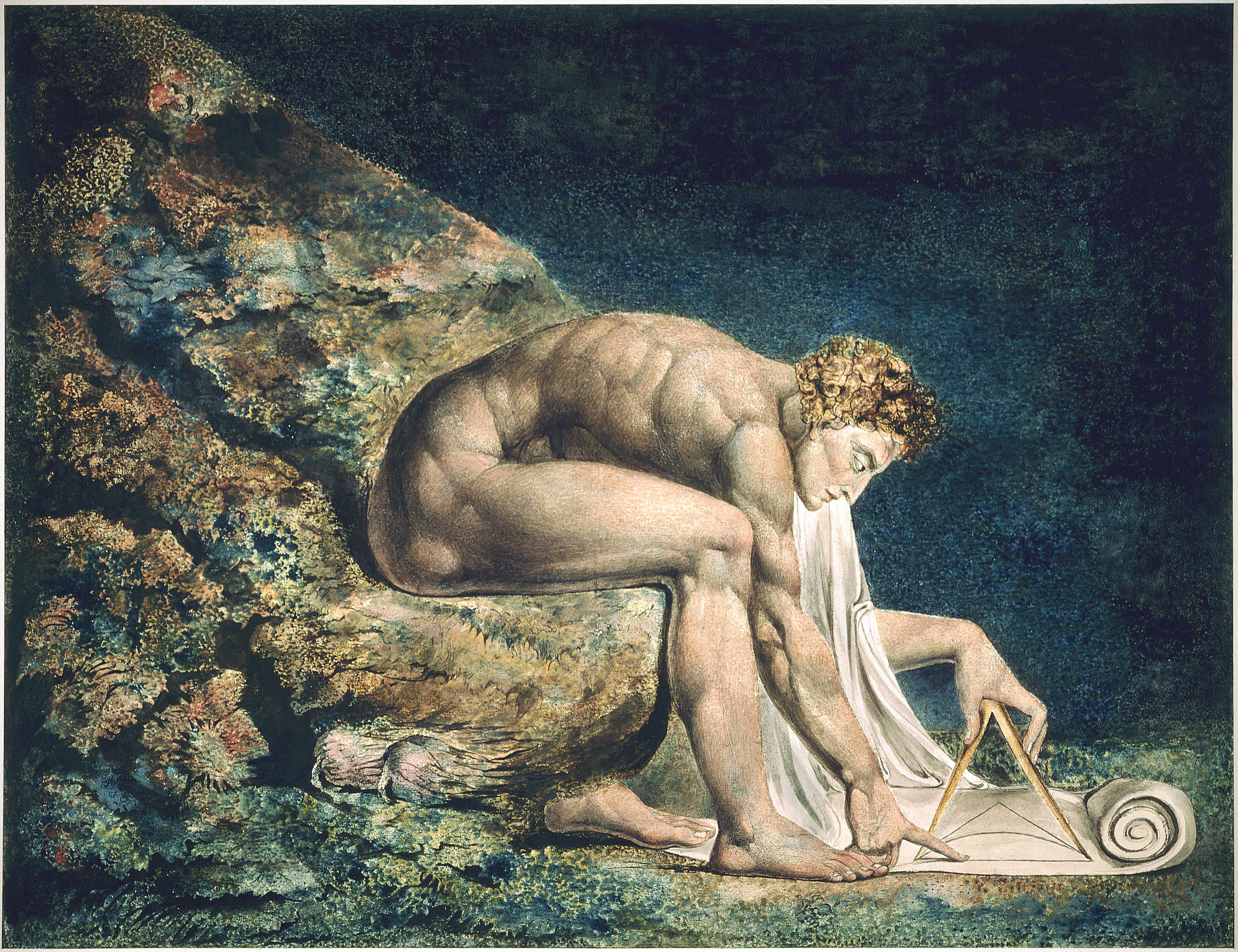
Four fundamental forces govern all interactions within the Universe. They are weak nuclear forces, strong nuclear forces, electromagnetism, and gravity. Of these, gravity is perhaps the most mysterious. While it has been understood for some time how this law of physics operates on the macro-scale – governing our Solar System, galaxies, and superclusters – how it interacts with the three other fundamental forces remains a mystery.
Naturally, human beings have had a basic understanding of this force since time immemorial. And when it comes to our modern understanding of gravity, credit is owed to one man who deciphered its properties and how it governs all things great and small – Sir Isaac Newton. Thanks to this 17th century English physicist and mathematician, our understanding of the Universe and the laws that govern it would forever be changed.
While we are all familiar with the iconic image of a man sitting beneath an apple tree and having one fall on his head, Newton’s theories on gravity also represented a culmination of years worth of research, which in turn was based on centuries of accumulated knowledge. He would present these theories in his magnum opus, Philosophiae Naturalis Principia Mathematica (“Mathematical Principles of Natural Philosophy”), which was first published in 1687.
In this volume, Newton laid out what would come to be known as his Three Laws of Motion, which were derived from Johannes Kepler’s Laws of Planetary Motion and his own mathematical description of gravity. These laws would lay the foundation of classical mechanics, and would remain unchallenged for centuries – until the 20th century and the emergence of Einstein’s Theory of Relativity.
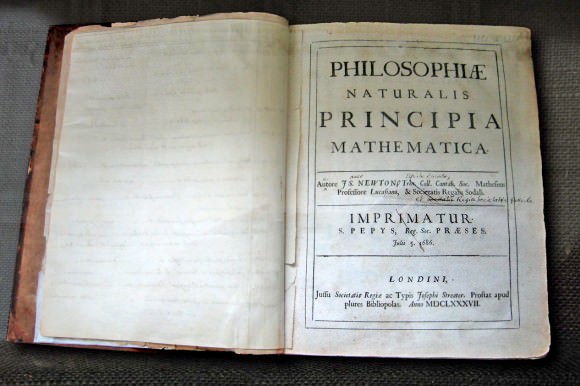
Physics by 17th Century:
The 17th century was a very auspicious time for the sciences, with major breakthroughs occurring in the fields of mathematics, physics, astronomy, biology and chemistry. Some of the greatest developments in the period include the development of the heliocentric model of the Solar System by Nicolaus Copernicus, the pioneering work with telescopes and observational astronomy by Galileo Galilei, and the development of modern optics.
It was also during this period that Johannes Kepler developed his Laws of Planetary Motion. Formulated between 1609 and 1619, these laws described the motion of the then-known planets (Mercury, Venus, Earth, Mars, Jupiter, and Saturn) around the Sun. They stated that:
- Planets move around the Sun in ellipses, with the Sun at one focus
- The line connecting the Sun to a planet sweeps equal areas in equal times.
- The square of the orbital period of a planet is proportional to the cube (3rd power) of the mean distance from the Sun in (or in other words–of the”semi-major axis” of the ellipse, half the sum of smallest and greatest distance from the Sun).
These laws resolved the remaining mathematical issues raised by Copernicus’ heliocentric model, thus removing all doubt that it was the correct model of the Universe. Working from these, Sir Isaac Newton began considering gravitation and its effect on the orbits of planets.

Newton’s Three Laws:
In 1678, Newton suffered a complete nervous breakdown due to overwork and a feud with fellow astronomer Robert Hooke. For the next few years, he withdrew from correspondence with other scientists, except where they initiated it, and renewed his interest in mechanics and astronomy. In the winter of 1680-81, the appearance of a comet, about which he corresponded with John Flamsteed (England’s Astronomer Royal) also renewed his interest in astronomy.
After reviewing Kepler’s Laws of Motion, Newton developed a mathematical proof that the elliptical form of planetary orbits would result from a centripetal force inversely proportional to the square of the radius vector. Newton communicated these results to Edmond Halley (discoverer of “Haley’s Comet”) and to the Royal Society in his De motu corporum in gyrum.
This tract, published in 1684, contained the seed of what Newton would expand to form his magnum opus, the Philosophiae Naturalis Principia Mathematica. This treatise, which was published in July of 1687, contained Newton’s three laws of motion, which stated that:
- When viewed in an inertial reference frame, an object either remains at rest or continues to move at a constant velocity, unless acted upon by an external force.
- The vector sum of the external forces (F) on an object is equal to the mass (m) of that object multiplied by the acceleration vector (a) of the object. In mathematical form, this is expressed as: F=ma
- When one body exerts a force on a second body, the second body simultaneously exerts a force equal in magnitude and opposite in direction on the first body.
Together, these laws described the relationship between any object, the forces acting upon it and the resulting motion, laying the foundation for classical mechanics. The laws also allowed Newton to calculate the mass of each planet, the flattening of the Earth at the poles, and the bulge at the equator, and how the gravitational pull of the Sun and Moon create the Earth’s tides.
In the same work, Newton presented a calculus-like method of geometrical analysis using ‘first and last ratios’, worked out the speed of sound in air (based on Boyle’s Law), accounted for the procession of the equinoxes (which he showed were a result of the Moon’s gravitational attraction to the Earth), initiated the gravitational study of the irregularities in the motion of the moon, provided a theory for the determination of the orbits of comets, and much more.
Newton and the “Apple Incident”:
The story of Newton coming up with his theory of universal gravitation as a result of an apple falling on his head has become a staple of popular culture. And while it has often been argued that the story is apocryphal and Newton did not devise his theory at any one moment, Newton himself told the story many times and claimed that the incident had inspired him.
In addition, the writing’s of William Stukeley – an English clergyman, antiquarian and fellow member of the Royal Society – have confirmed the story. But rather than the comical representation of the apple striking Newton on the head, Stukeley described in his Memoirs of Sir Isaac Newton’s Life (1752) a conversation in which Newton described pondering the nature of gravity while watching an apple fall.
“…we went into the garden, & drank thea under the shade of some appletrees; only he, & my self. amidst other discourse, he told me, he was just in the same situation, as when formerly, the notion of gravitation came into his mind. “why should that apple always descend perpendicularly to the ground,” thought he to himself; occasion’d by the fall of an apple…”
John Conduitt, Newton’s assistant at the Royal Mint (who eventually married his niece), also described hearing the story in his own account of Newton’s life. According to Conduitt, the incident took place in 1666 when Newton was traveling to meet his mother in Lincolnshire. While meandering in the garden, he contemplated how gravity’s influence extended far beyond Earth, responsible for the falling of apple as well as the Moon’s orbit.
Similarly, Voltaire wrote n his Essay on Epic Poetry (1727) that Newton had first thought of the system of gravitation while walking in his garden and watching an apple fall from a tree. This is consistent with Newton’s notes from the 1660s, which show that he was grappling with the idea of how terrestrial gravity extends, in an inverse-square proportion, to the Moon.
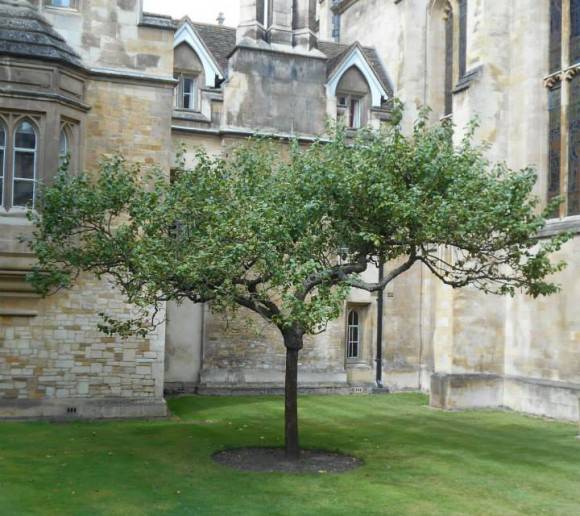
However, it would take him two more decades to fully develop his theories to the point that he was able to offer mathematical proofs, as demonstrated in the Principia. Once that was complete, he deduced that the same force that makes an object fall to the ground was responsible for other orbital motions. Hence, he named it “universal gravitation”.
Various trees are claimed to be “the” apple tree which Newton describes. The King’s School, Grantham, claims their school purchased the original tree, uprooted it, and transported it to the headmaster’s garden some years later. However, the National Trust, which holds the Woolsthorpe Manor (where Newton grew up) in trust, claims that the tree still resides in their garden. A descendant of the original tree can be seen growing outside the main gate of Trinity College, Cambridge, below the room Newton lived in when he studied there.
Newton’s work would have a profound effect on the sciences, with its principles remaining canon for the following 200 years. It also informed the concept of universal gravitation, which became the mainstay of modern astronomy, and would not be revised until the 20th century – with the discovery of quantum mechanics and Einstein’s theory of General Relativity.
We have written many interesting articles about gravity here at Universe Today. Here is Who was Sir Isaac Newton?, Who Was Galileo Galilei?, What Is the Force of Gravity?, and What is the Gravitational Constant?
Astronomy Cast has some two good episodes on the subject. Here’s Episode 37: Gravitational Lensing, and Episode 102: Gravity,
Sources:
How Do We Terraform Jupiter’s Moons?
Continuing with our “Definitive Guide to Terraforming“, Universe Today is happy to present to our guide to terraforming Jupiter’s Moons. Much like terraforming the inner Solar System, it might be feasible someday. But should we?
Fans of Arthur C. Clarke may recall how in his novel, 2010: Odyssey Two (or the movie adaptation called 2010: The Year We Make Contact), an alien species turned Jupiter into a new star. In so doing, Jupiter’s moon Europa was permanently terraformed, as its icy surface melted, an atmosphere formed, and all the life living in the moon’s oceans began to emerge and thrive on the surface.
As we explained in a previous video (“Could Jupiter Become a Star“) turning Jupiter into a star is not exactly doable (not yet, anyway). However, there are several proposals on how we could go about transforming some of Jupiter’s moons in order to make them habitable by human beings. In short, it is possible that humans could terraform one of more of the Jovians to make it suitable for full-scale human settlement someday.
Continue reading “How Do We Terraform Jupiter’s Moons?”
Who was Albert Einstein?
At the end of the millennium, Physics World magazine conducted a poll where they asked 100 of the world’s leading physicists who they considered to be the top 10 greatest scientist of all time. The number one scientist they identified was Albert Einstein, with Sir Isaac Newton coming in second. Beyond being the most famous scientist who ever lived, Albert Einstein is also a household name, synonymous with genius and endless creativity.
As the discoverer of Special and General Relativity, Einstein revolutionized our understanding of time, space, and universe. This discovery, along with the development of quantum mechanics, effectively brought to an end the era of Newtonian Physics and gave rise to the modern age. Whereas the previous two centuries had been characterized by universal gravitation and fixed frames of reference, Einstein helped usher in an age of uncertainty, black holes and “scary action at a distance”.
Continue reading “Who was Albert Einstein?”
Who Was Galileo Galilei?
When it comes to scientists who revolutionized the way we think of the universe, few names stand out like Galileo Galilei. A noted inventor, physicist, engineer and astronomer, Galileo was one of the greatest contributors to the Scientific Revolution. He build telescopes, designed a compass for surveying and military use, created a revolutionary pumping system, and developed physical laws that were the precursors of Newton’s law of Universal Gravitation and Einstein’s Theory of Relativity.
But it was within the field of astronomy that Galileo made his most enduring impact. Using telescopes of his own design, he discovered Sunspots, the largest moons of Jupiter, surveyed The Moon, and demonstrated the validity of Copernicus’ heliocentric model of the universe. In so doing, he helped to revolutionize our understanding of the cosmos, our place in it, and helped to usher in an age where scientific reasoning trumped religious dogma.
Early Life:
Galileo was born in Pisa, Italy, in 1564, into a noble but poor family. He was the first of six children of Vincenzo Galilei and Giulia Ammannati, who’s father also had three children out of wedlock. Galileo was named after an ancestor, Galileo Bonaiuti (1370 – 1450), a noted physician, university teacher and politician who lived in Florence.
His father, a famous lutenist, composer and music theorist, had a great impact on Galileo; transmitting not only his talent for music, but skepticism of authority, the value of experimentation, and the value of measures of time and rhythm to achieve success.
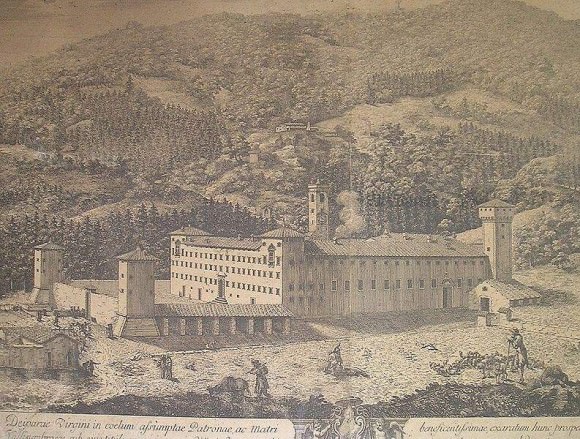
In 1572, when Galileo Galilei was eight, his family moved to Florence, leaving Galileo with his uncle Muzio Tedaldi (related to his mother through marriage) for two years.When he reached the age of ten, Galileo left Pisa to join his family in Florence and was tutored by Jacopo Borghini -a mathematician and professor from the university of Pisa.
Once he was old enough to be educated in a monastery, his parents sent him to the Camaldolese Monastery at Vallombrosa, located 35 km southeast of Florence. The Order was independent from the Benedictines, and combined the solitary life of the hermit with the strict life of a monk. Galileo apparently found this life attractive and intending to join the Order, but his father insisted that he study at the University of Pisa to become a doctor.
Education:
While at Pisa, Galileo began studying medicine, but his interest in the sciences quickly became evident. In 1581, he noticed a swinging chandelier, and became fascinated by the timing of its movements. To him, it became clear that the amount of time, regardless of how far it was swinging, was comparable to the beating of his heart.
When he returned home, he set up two pendulums of equal length, swinging one with a large sweep and the other with a small sweep, and found that they kept time together. These observations became the basis of his later work with pendulums to keep time – work which would also be picked up almost a century later when Christiaan Huygens designed the first officially-recognized pendulum clock.
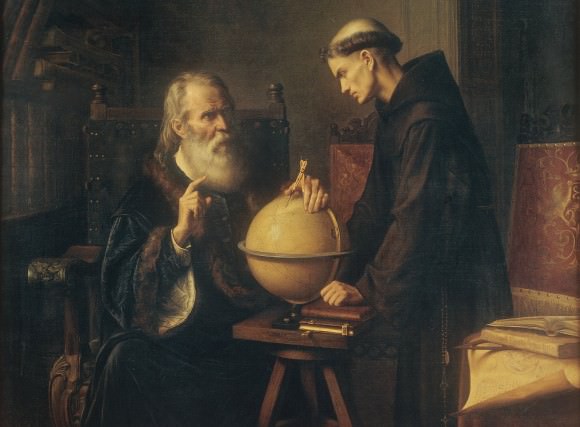
Shortly thereafter, Galileo accidentally attended a lecture on geometry, and talked his reluctant father into letting his study mathematics and natural philosophy instead of medicine. From that point onward, he began a steady processes of inventing, largely for the sake of appeasing his father’s desire for him to make money to pay off his siblings expenses (particularly those of his younger brother, Michelagnolo).
In 1589, Galileo was appointed to the chair of mathematics at the University of Pisa. In 1591, his father died, and he was entrusted with the care of his younger siblings. Being Professor of Mathematics at Pisa was not well paid, so Galileo lobbied for a more lucrative post. In 1592, this led to his appointment to the position of Professor of Mathematics at the University of Padua, where he taught Euclid’s geometry, mechanics, and astronomy until 1610.
During this period, Galileo made significant discoveries in both pure fundamental science as well as practical applied science. His multiple interests included the study of astrology, which at the time was a discipline tied to the studies of mathematics and astronomy. It was also while teaching the standard (geocentric) model of the universe that his interest in astronomy and the Copernican theory began to take off.
Telescopes:
In 1609, Galileo received a letter telling him about a spyglass that a Dutchman had shown in Venice. Using his own technical skills as a mathematician and as a craftsman, Galileo began to make a series of telescopes whose optical performance was much better than that of the Dutch instrument.

As he would later write in his 1610 tract Sidereus Nuncius (“The Starry Messenger”):
“About ten months ago a report reached my ears that a certain Fleming had constructed a spyglass by means of which visible objects, though very distant from the eye of the observer, were distinctly seen as if nearby. Of this truly remarkable effect several experiences were related, to which some persons believed while other denied them. A few days later the report was confirmed by a letter I received from a Frenchman in Paris, Jacques Badovere, which caused me to apply myself wholeheartedly to investigate means by which I might arrive at the invention of a similar instrument. This I did soon afterwards, my basis being the doctrine of refraction.”
His first telescope – which he constructed between June and July of 1609 – was made from available lenses and had a three-powered spyglass. To improve upon this, Galileo learned how to grind and polish his own lenses. By August, he had created an eight-powered telescope, which he presented to the Venetian Senate.
By the following October or November, he managed to improve upon this with the creation a twenty-powered telescope. Galileo saw a great deal of commercial and military applications of his instrument(which he called a perspicillum) for ships at sea. However, in 1610, he began turning his telescope to the heavens and made his most profound discoveries.

Achievements in Astronomy:
Using his telescope, Galileo began his career in astronomy by gazing at the Moon, where he discerned patterns of uneven and waning light. While not the first astronomer to do this, Galileo artistic’s training and knowledge of chiaroscuro – the use of strong contrasts between light and dark – allowed him to correctly deduce that these light patterns were the result of changes in elevation. Hence, Galileo was the first astronomer to discover lunar mountains and craters.
In The Starry Messenger, he also made topographical charts, estimating the heights of these mountains. In so doing, he challenged centuries of Aristotelian dogma that claimed that Moon, like the other planets, was a perfect, translucent sphere. By identifying that it had imperfections, in the forms of surface features, he began advancing the notion that the planets were similar to Earth.
Galileo also recorded his observations about the Milky Way in the Starry Messenger, which was previously believed to be nebulous. Instead, Galileo found that it was a multitude of stars packed so densely together that it appeared from a distance to look like clouds. He also reported that whereas the telescope resolved the planets into discs, the stars appeared as mere blazes of light, essentially unaltered in appearance by the telescope – thus suggesting that they were much farther away than previously thought.
Using his telescopes, Galileo also became one the first European astronomer to observe and study sunspots. Though there are records of previous instances of naked eye observations – such as in China (ca. 28 BCE), Anaxagoras in 467 BCE, and by Kepler in 1607 – they were not identifies as being imperfections on the surface of the Sun. In many cases, such as Kepler’s, it was thought that the spots were transits of Mercury.
In addition, there is also controversy over who was the first to observe sunspots during the 17th century using a telescope. Whereas Galileo is believed to have observed them in 1610, he did not publish about them and only began speaking to astronomers in Rome about them by the following year. In that time, German astronomer Christoph Scheiner had been reportedly observing them using a helioscope of his own design.
At around the same time, the Frisian astronomers Johannes and David Fabricius published a description of sunspots in June 1611. Johannes book, De Maculis in Sole Observatis (“On the Spots Observed in the Sun”) was published in autumn of 1611, thus securing credit for him and his father.
In any case, it was Galileo who properly identified sunspots as imperfections on the surface of the Sun, rather than being satellites of the Sun – an explanation that Scheiner, a Jesuit missionary, advanced in order to preserve his beliefs in the perfection of the Sun.
Using a technique of projecting the Sun’s image through the telescope onto a piece of paper, Galileo deduced that sunspots were, in fact, on the surface of the Sun or in its atmosphere. This presented another challenge to the Aristotelian and Ptolemaic view of the heavens, since it demonstrated that the Sun itself had imperfections.
On January 7th, 1610, Galileo pointed his telescope towards Jupiter and observed what he described in Nuncius as “three fixed stars, totally invisible by their smallness” that were all close to Jupiter and in line with its equator. Observations on subsequent nights showed that the positions of these “stars” had changed relative to Jupiter, and in a way that was not consistent with them being part of the background stars.
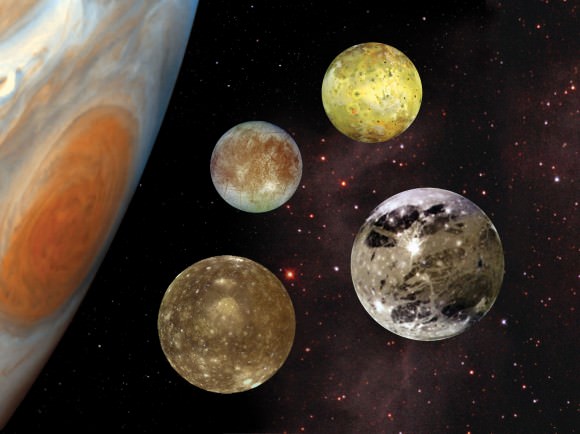
By January 10th, he noted that one had disappeared, which he attributed to it being hidden behind Jupiter. From this, he concluded that the stars were in fact orbiting Jupiter, and they were satellites of it. By January 13th, he discovered a fourth, and named them the Medicean stars, in honor of his future patron, Cosimo II de’ Medici, Grand Duke of Tuscany, and his three brothers.
Later astronomers, however, renamed them the Galilean Moons in honour of their discoverer. By the 20th century, these satellites would come to be known by their current names – Io, Europa, Ganymede, and Callisto – which had been suggested by 17th century German astronomer Simon Marius, apparently at the behest of Johannes Kepler.
Galileo’s observations of these satellites proved to be another major controversy. For the first time, a planet other than Earth was shown to have satellites orbiting it, which constituted yet another nail in the coffin of the geocentric model of the universe. His observations were independently confirmed afterwards, and Galileo continued to observe the satellites them and even obtained remarkably accurate estimates for their periods by 1611.
Heliocentrism:
Galileo’s greatest contribution to astronomy came in the form of his advancement of the Copernican model of the universe (i.e. heliocentrism). This began in 1610 with his publication of Sidereus Nuncius, which brought the issue of celestial imperfections before a wider audience. His work on sunspots and his observation of the Galilean Moons furthered this, revealing yet more inconsistencies in the currently accepted view of the heavens.

Other astronomical observations also led Galileo to champion the Copernican model over the traditional Aristotelian-Ptolemaic (aka. geocentric) view. From September 1610 onward, Galileo began observing Venus, noting that it exhibited a full set of phases similar to that of the Moon. The only explanation for this was that Venus was periodically between the Sun and Earth; while at other times, it was on the opposite side of the Sun.
According to the geocentric model of the universe, this should have been impossible, as Venus’ orbit placed it closer to Earth than the Sun – where it could only exhibit crescent and new phases. However, Galileo’s observations of it going through crescent, gibbous, full and new phases was consistent with the Copernican model, which established that Venus orbited the Sun within the Earth’s orbit.
These and other observations made the Ptolemaic model of the universe untenable. Thus, by the early 17th century, the great majority of astronomers began to convert to one of the various geo-heliocentric planetary models – such as the Tychonic, Capellan and Extended Capellan models. These all had the virtue of explaining problems in the geocentric model without engaging in the “heretical” notion that Earth revolved around the Sun.
In 1632, Galileo addressed the “Great Debate” in his treatise Dialogo sopra i due massimi sistemi del mondo (Dialogue Concerning the Two Chief World Systems), in which he advocated the heliocentric model over the geocentric. Using his own telescopic observations, modern physics and rigorous logic, Galileo’s arguments effectively undermined the basis of Aristotle and Ptolemy’s system for a growing and receptive audience.
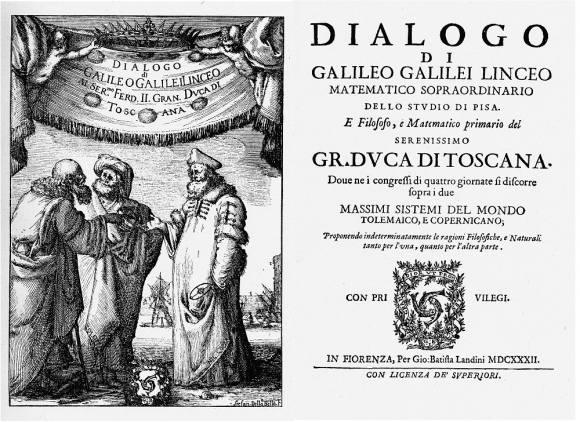
In the meantime, Johannes Kepler correctly identified the sources of tides on Earth – something which Galileo had become interesting in himself. But whereas Galileo attributed the ebb and flow of tides to the rotation of the Earth, Kepler ascribed this behavior to the influence of the Moon.
Combined with his accurate tables on the elliptical orbits of the planets (something Galileo rejected), the Copernican model was effectively proven. From the middle of the seventeenth century onward, there were few astronomers who were not Copernicans.
The Inquisition and House Arrest:
As a devout Catholic, Galileo often defended the heliocentric model of the universe using Scripture. In 1616, he wrote a letter to the Grand Duchess Christina, in which he argued for a non-literal interpretation of the Bible and espoused his belief in the heliocentric universe as a physical reality:
“I hold that the Sun is located at the center of the revolutions of the heavenly orbs and does not change place, and that the Earth rotates on itself and moves around it. Moreover … I confirm this view not only by refuting Ptolemy’s and Aristotle’s arguments, but also by producing many for the other side, especially some pertaining to physical effects whose causes perhaps cannot be determined in any other way, and other astronomical discoveries; these discoveries clearly confute the Ptolemaic system, and they agree admirably with this other position and confirm it.“
More importantly, he argued that the Bible is written in the language of the common person who is not an expert in astronomy. Scripture, he argued, teaches us how to go to heaven, not how the heavens go.
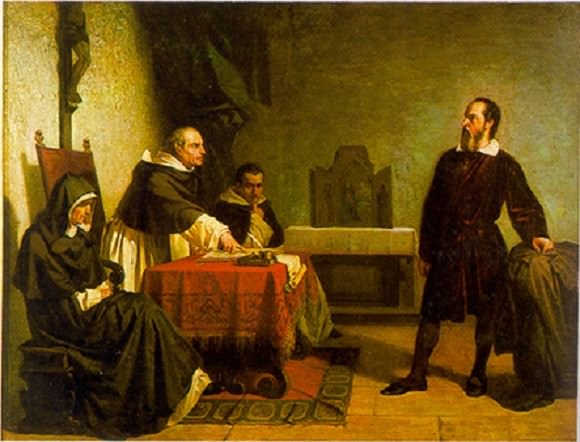
Initially, the Copernican model of the universe was not seen as an issue by the Roman Catholic Church or it’s most important interpreter of Scripture at the time – Cardinal Robert Bellarmine. However, in the wake of the Counter-Reformation, which began in 1545 in response to the Reformation, a more stringent attitude began to emerge towards anything seen as a challenge to papal authority.
Eventually, matters came to a head in 1615 when Pope Paul V (1552 – 1621) ordered that the Sacred Congregation of the Index (an Inquisition body charged with banning writings deemed “heretical”) make a ruling on Copernicanism. They condemned the teachings of Copernicus, and Galileo (who had not been personally involved in the trial) was forbidden to hold Copernican views.
However, things changed with the election of Cardinal Maffeo Barberini (Pope Urban VIII) in 1623. As a friend and admirer of Galileo’s, Barberini opposed the condemnation of Galileo, and gave formal authorization and papal permission for the publication of Dialogue Concerning the Two Chief World Systems.
However, Barberini stipulated that Galileo provide arguments for and against heliocentrism in the book, that he be careful not to advocate heliocentrism, and that his own views on the matter be included in Galileo’s book. Unfortunately, Galileo’s book proved to be a solid endorsement of heliocentrism and offended the Pope personally.
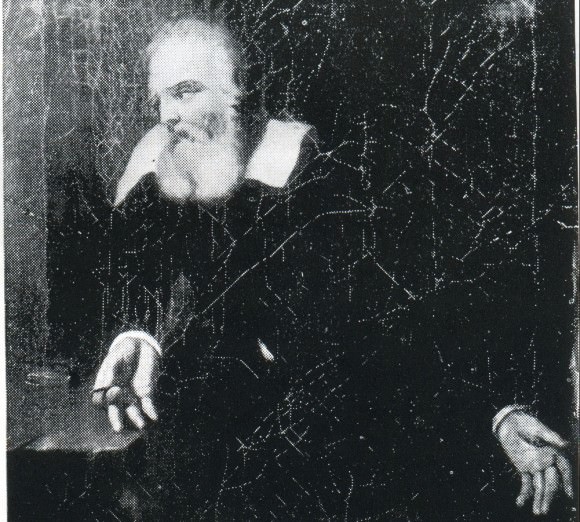
In it, the character of Simplicio, the defender of the Aristotelian geocentric view, is portrayed as an error-prone simpleton. To make matter worse, Galileo had the character Simplicio enunciate the views of Barberini at the close of the book, making it appear as though Pope Urban VIII himself was a simpleton and hence the subject of ridicule.
As a result, Galileo was brought before the Inquisition in February of 1633 and ordered to renounce his views. Whereas Galileo steadfastly defended his position and insisted on his innocence, he was eventually threatened with torture and declared guilty. The sentence of the Inquisition, delivered on June 22nd, contained three parts – that Galileo renounce Copernicanism, that he be placed under house arrest, and that the Dialogue be banned.
According to popular legend, after recanting his theory publicly that the Earth moved around the Sun, Galileo allegedly muttered the rebellious phrase: “E pur si muove” (“And yet it moves” in Latin). After a period of living with his friend, the Archbishop of Siena, Galileo returned to his villa at Arcetri (near Florence in 1634), where he spent the remainder of his life under house arrest.
Other Accomplishments:
In addition to his revolutionary work in astronomy and optics, Galileo is also credited with the invention of many scientific instruments and theories. Much of the devices he created were for the specific purpose of earning money to pay for his sibling’s expenses. However, they would also prove to have a profound impact in the fields of mechanics, engineering, navigation, surveying, and warfare.

In 1586, at the age of 22, Galileo made his first groundbreaking invention. Inspired by the story of Archimedes and his “Eureka” moment, Galileo began looking into how jewelers weighed precious metals in air and then by displacement to determine their specific gravity. Working from this, he eventually theorized of a better method, which he described in a treatise entitled La Bilancetta (“The Little Balance”).
In this tract, he described an accurate balance for weighing things in air and water, in which the part of the arm on which the counter weight was hung was wrapped with metal wire. The amount by which the counterweight had to be moved when weighing in water could then be determined very accurately by counting the number of turns of the wire. In so doing, the proportion of metals like gold to silver in the object could be read off directly.
In 1592, when Galileo was a professor of mathematics at the University of Padua, he made frequent trips to the Arsenal – the inner harbor where Venetian ships were outfitted. The Arsenal had been a place of practical invention and innovation for centuries, and Galileo used the opportunity to study mechanical devices in detail.
In 1593, he was consulted on the placement of oars in galleys and submitted a report in which he treated the oar as a lever and correctly made the water the fulcrum. A year later the Venetian Senate awarded him a patent for a device for raising water that relied on a single horse for the operation. This became the basis of modern pumps.

To some, Galileo’s Pump was a merely an improvement on the Archimedes Screw, which was first developed in the third century BCE and patented in the Venetian Republic in 1567. However, there is no apparent evidence connecting Galileo’s invention to Archimedes’ earlier and less sophisticated design.
In ca. 1593, Galileo constructed his own version of a thermoscope, a forerunner of the thermometer, that relied on the expansion and contraction of air in a bulb to move water in an attached tube. Over time, he and his colleagues worked to develop a numerical scale that would measure the heat based on the expansion of the water inside the tube.
The cannon, which was first introduced to Europe in 1325, had become a mainstay of war by Galileo’s time. Having become more sophisticated and mobile, gunners needed instruments to help them coordinate and calculate their fire. As such, between 1595 and 1598, Galileo devised an improved geometric and military compass for use by gunners and surveyors.
During the 16th century, Aristotelian physics was still the predominant way of explaining the behavior of bodies near the Earth. For example, it was believed that heavy bodies sought their natural place of rest – i.e at the center of things. As a result, no means existed to explain the behavior of pendulums, where a heavy body suspended from a rope would swing back and forth and not seek rest in the middle.

Already, Galileo had conducted experiments that demonstrated that heavier bodies did not fall faster than lighter ones – another belief consistent with Aristotelian theory. In addition, he also demonstrated that objects thrown into the air travel in parabolic arcs. Based on this and his fascination with the back and forth motion of a suspended weight, he began to research pendulums in 1588.
In 1602, he explained his observations in a letter to a friend, in which he described the principle of isochronism. According to Galileo, this principle asserted that the time it takes for the pendulum to swing is not linked to the arc of the pendulum, but rather the pendulum’s length. Comparing two pendulum’s of similar length, Galileo demonstrated that they would swing at the same speed, despite being pulled at different lengths.
According to Vincenzo Vivian, one of Galileo’s contemporaries, it was in 1641 while under house arrest that Galileo created a design for a pendulum clock. Unfortunately, being blind at the time, he was unable to complete it before his death in 1642. As a result, Christiaan Huygens’ publication of Horologrium Oscillatorium in 1657 is recognized as the first recorded proposal for a pendulum clock.
Death and Legacy:
Galileo died on January 8th, 1642, at the age of 77, due to fever and heart palpitations that had taken a toll on his health. The Grand Duke of Tuscany, Ferdinando II, wished to bury him in the main body of the Basilica of Santa Croce, next to the tombs of his father and other ancestors, and to erect a marble mausoleum in his honor.
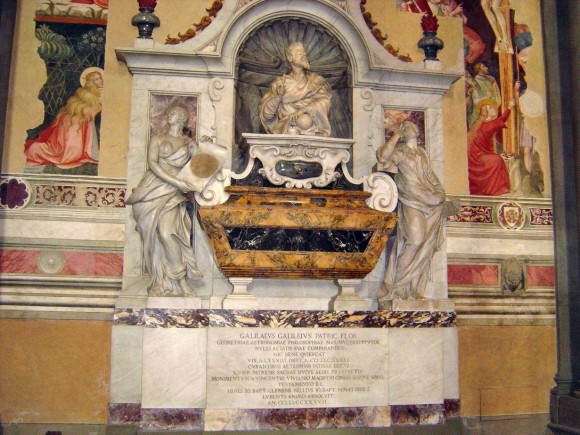
However, Pope Urban VIII objected on the basis that Galileo had been condemned by the Church, and his body was instead buried in a small room next to the novice’s chapel in the Basilica. However, after his death, the controversy surrounding his works and heliocentricm subsided, and the Inquisitions ban on his writing’s was lifted in 1718.
In 1737, his body was exhumed and reburied in the main body of the Basilica after a monument had been erected in his honor. During the exhumation, three fingers and a tooth were removed from his remains. One of these fingers, the middle finger from Galileo’s right hand, is currently on exhibition at the Museo Galileo in Florence, Italy.
In 1741, Pope Benedict XIV authorized the publication of an edition of Galileo’s complete scientific works which included a mildly censored version of the Dialogue. In 1758, the general prohibition against works advocating heliocentrism was removed from the Index of prohibited books, although the specific ban on uncensored versions of the Dialogue and Copernicus’s De Revolutionibus orbium coelestium (“On the Revolutions of the Heavenly Spheres“) remained.
All traces of official opposition to heliocentrism by the church disappeared in 1835 when works that espoused this view were finally dropped from the Index. And in 1939, Pope Pius XII described Galileo as being among the “most audacious heroes of research… not afraid of the stumbling blocks and the risks on the way, nor fearful of the funereal monuments”.
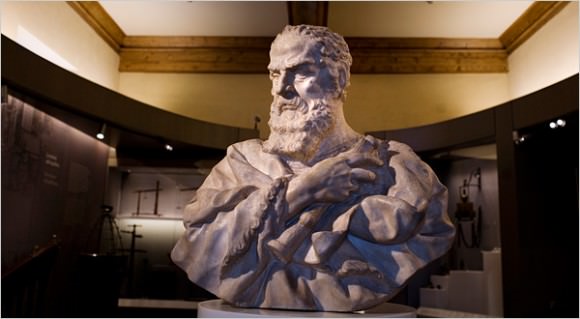
On October 31st, 1992, Pope John Paul II expressed regret for how the Galileo affair was handled, and issued a declaration acknowledging the errors committed by the Catholic Church tribunal. The affair had finally been put to rest and Galileo exonerated, though certain unclear statements issued by Pope Benedict XVI have led to renewed controversy and interest in recent years.
Alas, when it comes to the birth of modern science and those who helped create it, Galileo’s contributions are arguably unmatched. According to Stephen Hawking and Albert Einstein, Galileo was the father of modern science, his discoveries and investigations doing more to dispel the prevailing mood of superstition and dogma than anyone else in his time.
These include the discovery of craters and mountains on the Moon, the discovery of the four largest moons of Jupiter (Io, Europa, Ganymede and Callisto), the existence and nature of Sunspots, and the phases of Venus. These discoveries, combined with his logical and energetic defense of the Copernican model, made a lasting impact on astronomy and forever changed the way people look at the universe.
Galileo’s theoretical and experimental work on the motions of bodies, along with the largely independent work of Kepler and René Descartes, was a precursor of the classical mechanics developed by Sir Isaac Newton. His work with pendulums and time-keeping also previewed the work of Christiaan Huygens and the development of the pendulum clock, the most accurate timepiece of its day.
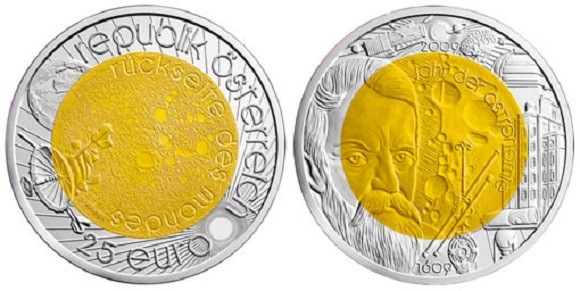
Galileo also put forward the basic principle of relativity, which states that the laws of physics are the same in any system that is moving at a constant speed in a straight line. This remains true, regardless of the system’s particular speed or direction, thus proving that there is no absolute motion or absolute rest. This principle provided the basic framework for Newton’s laws of motion and is central to Einstein’s special theory of relativity.
The United Nations chose 2009 to be the International Year of Astronomy, a global celebration of astronomy and its contributions to society and culture. The year 2009 was selected in part because it was the four-hundredth anniversary of Galileo first viewing the heavens with his a telescope he built himself.
A commemorative €25 coin was minted for the occasion, with the inset on the obverse side showing Galileo’s portrait and telescope, as well as one of his first drawings of the surface of the moon. In the silver circle that surrounds it, pictures of other telescopes – Isaac Newton’s Telescope, the observatory in Kremsmünster Abbey, a modern telescope, a radio telescope and a space telescope – are also shown.
Other scientific endeavors and principles are named after Galileo, including the NASA Galileo spacecraft, which was the first spacecraft to enter orbit around Jupiter. Operating from 1989 to 2003, the mission consisted of an orbiter that observed the Jovian system, and an atmospheric probe that made the first measurements of Jupiter’s atmosphere.
This mission found evidence of subsurface oceans on Europa, Ganymede and Callisto, and revealed the intensity of volcanic activity on Io. In 2003, the spacecraft was crashed into Jupiter’s atmosphere to avoid contamination of any of Jupiter’s moons.
The European Space Agency (ESA) is also developing a global satellite navigation system named Galileo. And in classical mechanics, the transformation between inertial systems is known as “Galilean Transformation“, which is denoted by the non-SI unit of acceleration Gal (sometimes known as the Galileo). Asteroid 697 Galilea is also named in his honor.
Yes, the sciences and humanity as a whole owes a great dept to Galileo. And as time goes on, and space exploration continues, it is likely we will continue to repay that debt by naming future missions – and perhaps even features on the Galilean Moons, should we ever settle there – after him. Seems like a small recompense for ushering in the age of modern science, no?
Universe Today has many interesting articles on Galileo, include the Galilean moons, Galileo’s inventions, and Galileo’s telescope.
For more information, check out the the Galileo Project and Galileo’s biography.
Astronomy Cast has an episode on choosing and using a telescope, and one which deals with the Galileo Spacecraft.
Who was Christiaan Huygens?

The 17th century was a very auspicious time for the sciences, with advancements being made in the fields of physics, mathematics, chemistry, and the natural sciences. But it was perhaps in the field of astronomy that the greatest achievements were made. In the space of a century, several planets and moons were observed for the first time, accurate models were made to predict the motions of the planets, and the law of universal gravitation was conceived.
In the midst of this, the name of Christiaan Huygens stands out among the rest. As one of the preeminent scientists of his time, he was pivotal in the development of clocks, mechanics and optics. And in the field of astronomy, he discovered Saturn’s Rings and its largest moon – Titan. Thanks to Huygens, subsequent generations of astronomers were inspired to explore the outer Solar System, leading to the discovery of other Cronian moons, Uranus, and Neptune in the following century.
Continue reading “Who was Christiaan Huygens?”
Io, Jupiter’s Volcanic Moon

Exploring the Solar System is like peeling an onion. With every layer removed, one finds fresh mysteries to ponder over, each one more confounding than the last. And this is certainly the case when it comes to Jupiter’s system of moons, particularly its four largest – Io, Europa, Ganymede and Callisto. Known as the Galilean Moons, in honor of their founder, these moons possess enough natural wonders to keep scientists busy for centuries.
As Jupiter’s innermost moon, it is also the fourth-largest moon in the Solar System, has the highest density of any known moon, and is the driest known object in the Solar System. It is also one of only four known bodies that experiences active volcanism and – with over 400 active volcanoes – it is the most geologically active body in the Solar System.
The Planet Neptune
Neptune is the eight planet from our Sun, one of the four gas giants, and one of the four outer planets in our Solar System. Since the “demotion” of Pluto by the IAU to the status of a dwarf planet – and/or Plutoid and Kuiper Belt Object (KBO) – Neptune is now considered to be the farthest planet in our Solar System.
As one of the planets that cannot be seen with the naked eye, Neptune was not discovered until relatively recently. And given its distance, it has only been observed up close on one occasion – in 1989 by the Voyager 2 spaceprobe. Nevertheless, what we’ve come to know about this gas (and ice) giant in that time has taught us much about the outer Solar System and the history of its formation.
Discovery and Naming:
Neptune’s discovery did not take place until the 19th century, though there are indications that it was observed before long that. For instance, Galileo’s drawings from December 28th, 1612, and January 27th, 1613, contained plotted points which are now known to match up with the positions of Neptune on those dates. However, in both cases, Galileo appeared to have mistaken it for a star.
1821, French astronomer Alexis Bouvard published astronomical tables for the orbit of Uranus. Subsequent observations revealed substantial deviations from the tables, which led Bouvard to hypothesize that an unknown body was perturbing Uranus’ orbit through gravitational interaction.
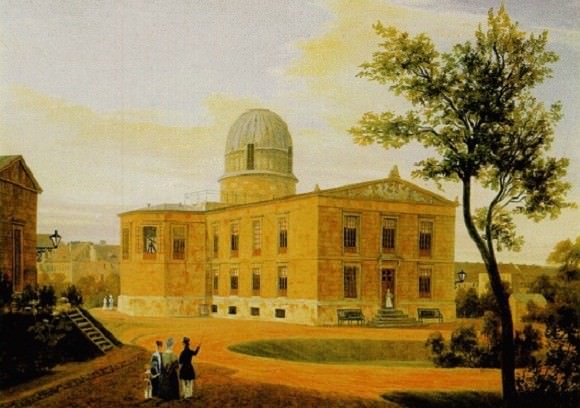
In 1843, English astronomer John Couch Adams began work on the orbit of Uranus using the data he had and produced several different estimates in the following years of the planet’s orbit. In 1845–46, Urbain Le Verrier, independently of Adams, developed his own calculations, which he shared with Johann Gottfried Galle of the Berlin Observatory. Galle confirmed the presence of a planet at the coordinates specified by Le Verrier on September 23rd, 1846.
The announcement of the discovery was met with controversy, as both Le Verrier and Adams claimed responsibility. Eventually, an international consensus emerged that both Le Verrier and Adams jointly deserved credit. However, a re-evaluation by historians in 1998 of the relevant historical documents led to the conclusion that Le Verrier was more directly responsible for the discovery and deserves the greater share of the credit.
Claiming the right of discovery, Le Verrier suggested the planet be named after himself, but this met with stiff resistance outside of France. He also suggested the name Neptune, which was gradually accepted by the international community. This was largely because it was consistent with the nomenclature of the other planets, all of which were named after deities from Greco-Roman mythology.
Neptune’s Size, Mass and Orbit:
With a mean radius of 24,622 ± 19 km, Neptune is the fourth largest planet in the Solar System and four times as large as Earth. But with a mass of 1.0243×1026 kg – which is roughly 17 times that of Earth – it is the third most massive, outranking Uranus. The planet has a very minor eccentricity of 0.0086, and orbits the Sun at a distance of 29.81 AU (4.459 x 109 km) at perihelion and 30.33 AU (4.537 x 109 km) at aphelion.
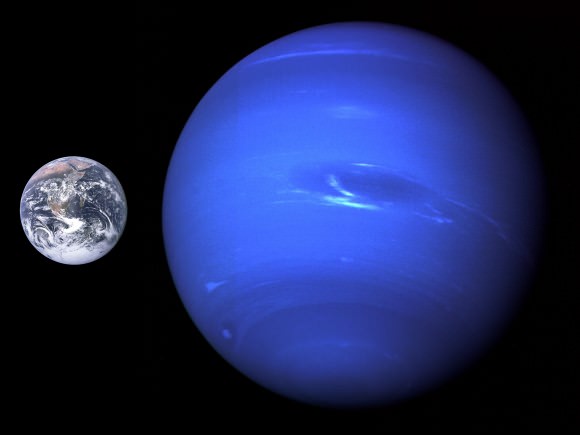
Neptune takes 16 h 6 min 36 s (0.6713 days) to complete a single sidereal rotation, and 164.8 Earth years to complete a single orbit around the Sun. This means that a single day lasts 67% as long on Neptune, whereas a year is the equivalent of approximately 60,190 Earth days (or 89,666 Neptunian days).
Because Neptune’s axial tilt (28.32°) is similar to that of Earth (~23°) and Mars (~25°), the planet experiences similar seasonal changes. Combined with its long orbital period, this means that the seasons last for forty Earth years. Also owing to its axial tilt being comparable to Earth’s is the fact that the variation in the length of its day over the course of the year is not any more extreme than it on Earth.
Neptune’s orbit also has a profound impact on the region directly beyond it, known as the Kuiper Belt (otherwise known as the “Trans-Neptunian Region”). Much in the same way that Jupiter’s gravity dominates the Asteroid Belt, shaping its structure, so Neptune’s gravity dominates the Kuiper Belt. Over the age of the Solar System, certain regions of the Kuiper belt became destabilised by Neptune’s gravity, creating gaps in the Kuiper belt’s structure.
There also exists orbits within these empty regions where objects can survive for the age of the Solar System. These resonances occur when Neptune’s orbital period is a precise fraction of that of the object – meaning they complete a fraction of an orbit for every orbit made by Neptune. The most heavily populated resonance in the Kuiper belt, with over 200 known objects, is the 2:3 resonance.
Objects in this resonance complete 2 orbits for every 3 of Neptune, and are known as plutinos because the largest of the known Kuiper belt objects, Pluto, is among them. Although Pluto crosses Neptune’s orbit regularly, the 2:3 resonance ensures they can never collide.
Neptune has a number of known trojan objects occupying both the Sun–Neptune L4 and L5 Lagrangian Points – regions of gravitational stability leading and trailing Neptune in its orbit. Some Neptune trojans are remarkably stable in their orbits, and are likely to have formed alongside Neptune rather than being captured.
Neptune’s Composition:
Due to its smaller size and higher concentrations of volatiles relative to Jupiter and Saturn, Neptune (much like Uranus) is often referred to as an “ice giant” – a subclass of a giant planet. Also like Uranus, Neptune’s internal structure is differentiated between a rocky core consisting of silicates and metals; a mantle consisting of water, ammonia and methane ices; and an atmosphere consisting of hydrogen, helium and methane gas.
The core of Neptune is composed of iron, nickel and silicates, with an interior model giving it a mass about 1.2 times that of Earth. The pressure at the center is estimated to be 7 Mbar (700 GPa), about twice as high as that at the center of Earth, and with temperatures as high as 5,400 K. At a depth of 7000 km, the conditions may be such that methane decomposes into diamond crystals that rain downwards like hailstones.
The mantle is equivalent to 10 – 15 Earth masses and is rich in water, ammonia and methane. This mixture is referred to as icy even though it is a hot, dense fluid, and is sometimes called a “water-ammonia ocean”. Meanwhile, the atmosphere forms about 5% to 10% of its mass and extends perhaps 10% to 20% of the way towards the core, where it reaches pressures of about 10 GPa – or about 100,000 times that of Earth’s atmosphere.
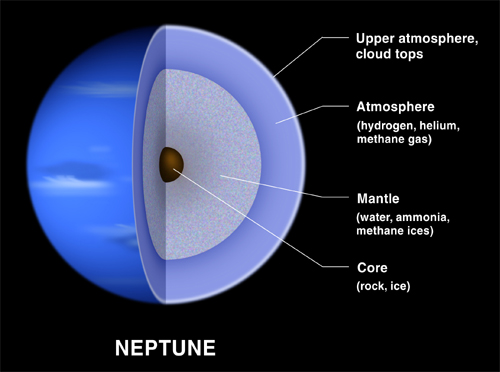
Increasing concentrations of methane, ammonia and water are found in the lower regions of the atmosphere. Unlike Uranus, Neptune’s composition has a higher volume of ocean, whereas Uranus has a smaller mantle.
Neptune’s Atmosphere:
At high altitudes, Neptune’s atmosphere is 80% hydrogen and 19% helium, with a trace amount of methane. As with Uranus, this absorption of red light by the atmospheric methane is part of what gives Neptune its blue hue, although Neptune’s is darker and more vivid. Because Neptune’s atmospheric methane content is similar to that of Uranus, some unknown atmospheric constituent is thought to contribute to Neptune’s more intense coloring.
Neptune’s atmosphere is subdivided into two main regions: the lower troposphere (where temperature decreases with altitude), and the stratosphere (where temperature increases with altitude). The boundary between the two, the tropopause, lies at a pressure of 0.1 bars (10 kPa). The stratosphere then gives way to the thermosphere at a pressure lower than 10-5 to 10-4 microbars (1 to 10 Pa), which gradually transitions to the exosphere.
Neptune’s spectra suggest that its lower stratosphere is hazy due to condensation of products caused by the interaction of ultraviolet radiation and methane (i.e. photolysis), which produces compounds such as ethane and ethyne. The stratosphere is also home to trace amounts of carbon monoxide and hydrogen cyanide, which are responsible for Neptune’s stratosphere being warmer than that of Uranus.

For reasons that remain obscure, the planet’s thermosphere experiences unusually high temperatures of about 750 K (476.85 °C/890 °F). The planet is too far from the Sun for this heat to be generated by ultraviolet radiation, which means another heating mechanism is involved – which could be the atmosphere’s interaction with ion’s in the planet’s magnetic field, or gravity waves from the planet’s interior that dissipate in the atmosphere.
Because Neptune is not a solid body, its atmosphere undergoes differential rotation. The wide equatorial zone rotates with a period of about 18 hours, which is slower than the 16.1-hour rotation of the planet’s magnetic field. By contrast, the reverse is true for the polar regions where the rotation period is 12 hours.
This differential rotation is the most pronounced of any planet in the Solar System, and results in strong latitudinal wind shear and violent storms. The three most impressive were all spotted in 1989 by the Voyager 2 space probe, and then named based on their appearances.
The first to be spotted was a massive anticyclonic storm measuring 13,000 x 6,600 km and resembling the Great Red Spot of Jupiter. Known as the Great Dark Spot, this storm was not spotted five later (Nov. 2nd, 1994) when the Hubble Space Telescope looked for it. Instead, a new storm that was very similar in appearance was found in the planet’s northern hemisphere, suggesting that these storms have a shorter life span than Jupiter’s.

The Scooter is another storm, a white cloud group located farther south than the Great Dark Spot. This nickname first arose during the months leading up to the Voyager 2 encounter in 1989, when the cloud group was observed moving at speeds faster than the Great Dark Spot.
The Small Dark Spot, a southern cyclonic storm, was the second-most-intense storm observed during the 1989 encounter. It was initially completely dark; but as Voyager 2 approached the planet, a bright core developed and could be seen in most of the highest-resolution images.
Neptune’s Moons:
Neptune has 14 known satellites, all but one of which are named after Greek and Roman deities of the sea (S/2004 N 1 is currently unnamed). These moons are divided into two groups – the regular and irregular moons – based on their orbit and proximity to Neptune. Neptune’s Regular Moons – Naiad, Thalassa, Despina, Galatea, Larissa, S/2004 N 1, and Proteus – are those that are closest to the planet and which follow circular, prograde orbits that lie in the planet’s equatorial plane.
They range in distance from 48,227 km (Naiad) to 117,646 km (Proteus) from Neptune, and all but the outermost two (S/2004 N 1, and Proteus) orbit Neptune slower than its orbital period of 0.6713 days. Based on observational data and assumed densities, these moons range in size and mass from 96 x 60 x 52 km and 1.9 x 1017 kg (Naiad) to 436 x 416 x 402 km and 50.35 x 1017 kg (Proteus).
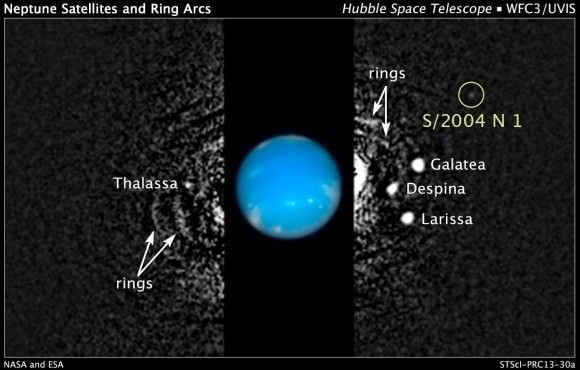
With the exception of Larissa and Proteus (which are largely rounded) all of Neptune’s inner moons are believed to be elongated in shape. Their spectra also indicates that they are made from water ice contaminated by some very dark material, probably organic compounds. In this respect, the inner Neptunian moons are similar to the inner moons of Uranus.
Neptune’s irregular moons consist of the planet’s remaining satellites (including Triton). They generally follow inclined eccentric and often retrograde orbits far from Neptune. The only exception is Triton, which orbits close to the planet, following a circular orbit, though retrograde and inclined.
In order of their distance from the planet, the irregular moons are Triton, Nereid, Halimede, Sao, Laomedeia, Neso and Psamathe – a group that includes both prograde and retrograde objects. With the exception of Triton and Nereid, Neptune’s irregular moons are similar to those of other giant planets and are believed to have been gravitationally captured by Neptune.
In terms of size and mass, the irregular moons are relatively consistent, ranging from approximately 40 km in diameter and 4 x 1016 kg in mass (Psamathe) to 62 km and 16 x 1016 kg for Halimede. Triton and Nereid are unusual irregular satellites and are thus treated separately from the other five irregular Neptunian moons. Between these two and the other irregular moons, four major differences have been noted.
First of all, they are the largest two known irregular moons in the Solar System. Triton itself is almost an order of magnitude larger than all other known irregular moons and comprises more than 99.5% of all the mass known to orbit Neptune (including the planet’s rings and thirteen other known moons).
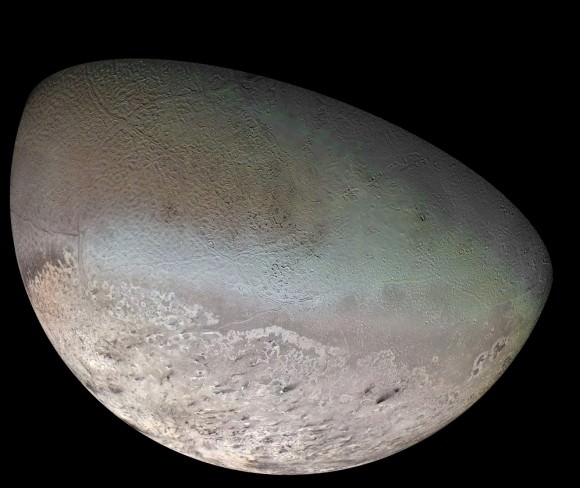
Secondly, they both have atypically small semi-major axes, with Triton’s being over an order of magnitude smaller than those of all other known irregular moons. Thirdly, they both have unusual orbital eccentricities: Nereid has one of the most eccentric orbits of any known irregular satellite, and Triton’s orbit is a nearly perfect circle. Finally, Nereid also has the lowest inclination of any known irregular satellite
With a mean diameter of around 2700 km and a mass of 214080 ± 520 x 1017 kg, Triton is the largest of Neptune’s moons, and the only one large enough to achieve hydrostatic equilibrium (i.e. is spherical in shape). At a distance of 354,759 km from Neptune, it also sits between the planet’s inner and outer moons.
Triton follows a retrograde and quasi-circular orbit, and is composed largely of nitrogen, methane, carbon dioxide and water ices. With a geometric albedo of more than 70% and a Bond albedo as high as 90%, it is also one of the brightest objects in the Solar System. The surface has a reddish tint, owning to the interaction of ultraviolet radiation and methane, causing tholins.
Triton is also one of the coldest moons in the Solar System, with surface temperature of about 38 K (-235.2 °C). However, owing to the moon being geologically active (which results in cryovolcanism) and surface temperature variations that cause sublimation, Triton is one of only two moons in the Solar System that has a substantial atmosphere. Much like it’s surface, this atmosphere is composed primarily of nitrogen with small amounts of methane and carbon monoxide, and with an estimated pressure of about 14 nanobar.
Triton has a relatively high density of about 2 g/cm3 indicating that rocks constitute about two thirds of its mass, and ices (mainly water ice) the remaining one third. There also may be a layer of liquid water deep inside Triton, forming a subterranean ocean. Surface features include the large southern polar cap, older cratered planes cross-cut by graben and scarps, as well as youthful features caused by endogenic resurfacing.
Because of its retrograde orbit and relative proximity to Neptune (closer than the Moon is to Earth), Triton is grouped with the planet’s irregular moons (see below). In addition, it is believed to be a captured object, possibly a dwarf planet that was once part of the Kuiper Belt. At the same time, these orbital characteristics are the reason why Triton experiences tidal deceleration. and will eventually spiral inward and collide with the planet in about 3.6 billion years.
Nereid is the third-largest moon of Neptune. It has a prograde but very eccentric orbit and is believed to be a former regular satellite that was scattered to its current orbit through gravitational interactions during Triton’s capture. Water ice has been spectroscopically detected on its surface. Nereid shows large, irregular variations in its visible magnitude, which are probably caused by forced precession or chaotic rotation combined with an elongated shape and bright or dark spots on the surface.
Neptune’s Ring System:
Neptune has five rings, all of which are named after astronomers who made important discoveries about the planet – Galle, Le Verrier, Lassell, Arago, and Adams. The rings are composed of at least 20% dust (with some containing as much as 70%) while the rest of the material consists of small rocks. The planet’s rings are difficult to see because they are dark and vary in density and size.
The Galle ring was named after Johann Gottfried Galle, the first person to see the planet using a telescope; and at 41,000–43,000 km, it is the nearest of Neptune’s rings. The La Verrier ring – which is very narrow at 113 km in width – is named after French astronomer Urbain Le Verrier, the planet’s co-founder.
At a distance of between 53,200 and 57,200 km from Neptune (giving it a width of 4,000 km) the Lassell ring is the widest of Neptune’s rings. This ring is named after William Lassell, the English astronomer who discovered Triton just seventeen days after Neptune was discovered. The Arago ring is 57,200 kilometers from the planet and less than 100 kilometers wide. This ring section is named after Francois Arago, Le Verrier’s mentor and the astronomer who played an active role in the dispute over who deserved credit for discovering Neptune.
The outer Adams ring was named after John Couch Adams, who is credited with the co-discovery of Neptune. Although the ring is narrow at only 35 kilometers wide, it is the most famous of the five due to its arcs. These arcs accord with areas in the ring system where the material of the rings is grouped together in a clump, and are the brightest and most easily observed parts of the ring system.
Although the Adams ring has five arcs, the three most famous are the “Liberty”, “Equality”, and “Fraternity” arcs. Scientists have been traditionally unable to explain the existence of these arcs because, according to the laws of motion, they should distribute the material uniformly throughout the rings. However, stronomers now estimate that the arcs are corralled into their current form by the gravitational effects of Galatea, which sits just inward from the ring.
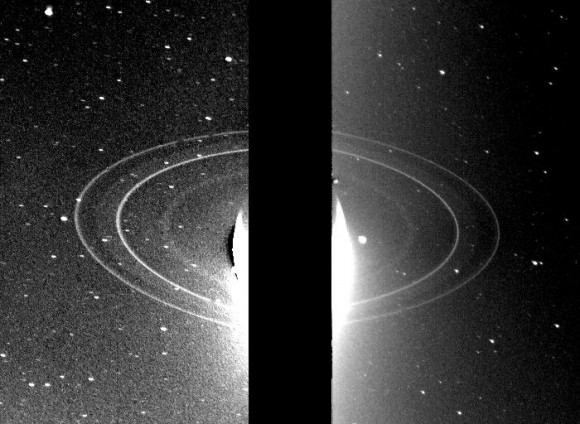
The rings of Neptune are very dark, and probably made of organic compounds that have been altered due to exposition to cosmic radiation. This is similar to the rings of Uranus, but very different to the icy rings around Saturn. They seem to contain a large quantity of micrometer-sized dust, similar in size to the particles in the rings of Jupiter.
It’s believed that the rings of Neptune are relatively young – much younger than the age of the Solar System, and much younger than the age of Uranus’ rings. Consistent with the theory that Triton was a KBO that was seized, by Neptune’s gravity, they are believed to be the result of a collision between some of the planet’s original moons.
Exploration:
The Voyager 2 probe is the only spacecraft to have ever visited Neptune. The spacecraft’s closest approach to the planet occurred on August 25th, 1989, which took place at a distance of 4,800 km (3,000 miles) above Neptune’s north pole. Because this was the last major planet the spacecraft could visit, it was decided to make a close flyby of the moon Triton – similar to what had been done for Voyager 1‘s encounter with Saturn and its moon Titan.
The spacecraft performed a near-encounter with the moon Nereid before it came to within 4,400 km of Neptune’s atmosphere on August 25th, then passed close to the planet’s largest moon Triton later the same day. The spacecraft verified the existence of a magnetic field surrounding the planet and discovered that the field was offset from the center and tilted in a manner similar to the field around Uranus.
Neptune’s rotation period was determined using measurements of radio emissions and Voyager 2 also showed that Neptune had a surprisingly active weather system. Six new moons were discovered during the flyby, and the planet was shown to have more than one ring.
While no missions to Neptune are currently being planned, some hypothetical missions have been suggested. For instance, a possible Flagship Mission has been envisioned by NASA to take place sometime during the late 2020s or early 2030s. Other proposals include a possible Cassini-Huygens-style “Neptune Orbiter with Probes”, which was suggested back in 2003.
Another, more recent proposal by NASA was for Argo – a flyby spacecraft that would be launched in 2019, which would visit Jupiter, Saturn, Neptune, and a Kuiper belt object. The focus would be on Neptune and its largest moon Triton, which would be investigated around 2029.
With its icy-blue color, liquid surface, and wavy weather patterns, Neptune was appropriately named after the Roman god of the sea. And given its distance from our planet, there is still a great deal that remains to be learned about it. In the coming decades, one can only hope that a mission to the outer Solar System and/or Kuiper Belt includes a flyby of Neptune.
We have many interesting articles about Neptune here at Universe Today. Below is a comprehensive list for your viewing (and possibly researching) pleasure!
Characteristics of Neptune:
- Neptune Fact Sheet
- How Big is Neptune?
- What is Neptune Made Of?
- Diameter of Neptune
- Density of Neptune
- Gravity on Neptune
- Mass of Neptune
- Axis Tilt of Neptune
- Size of Neptune
- Radius of Neptune
- Temperature of Neptune
- Neptune Compared to Earth
Position and Movement of Neptune:
- How Long is a Day on Neptune?
- How Far is Neptune from Earth?
- Orbit of Neptune
- How Long is a Year on Neptune?
- How Long Does it Take Neptune to Orbit the Sun?
- Neptune’s Distance from the Sun
Neptune’s Moon and Rings:
History of Neptune:
Neptune’s Surface and Structure:





